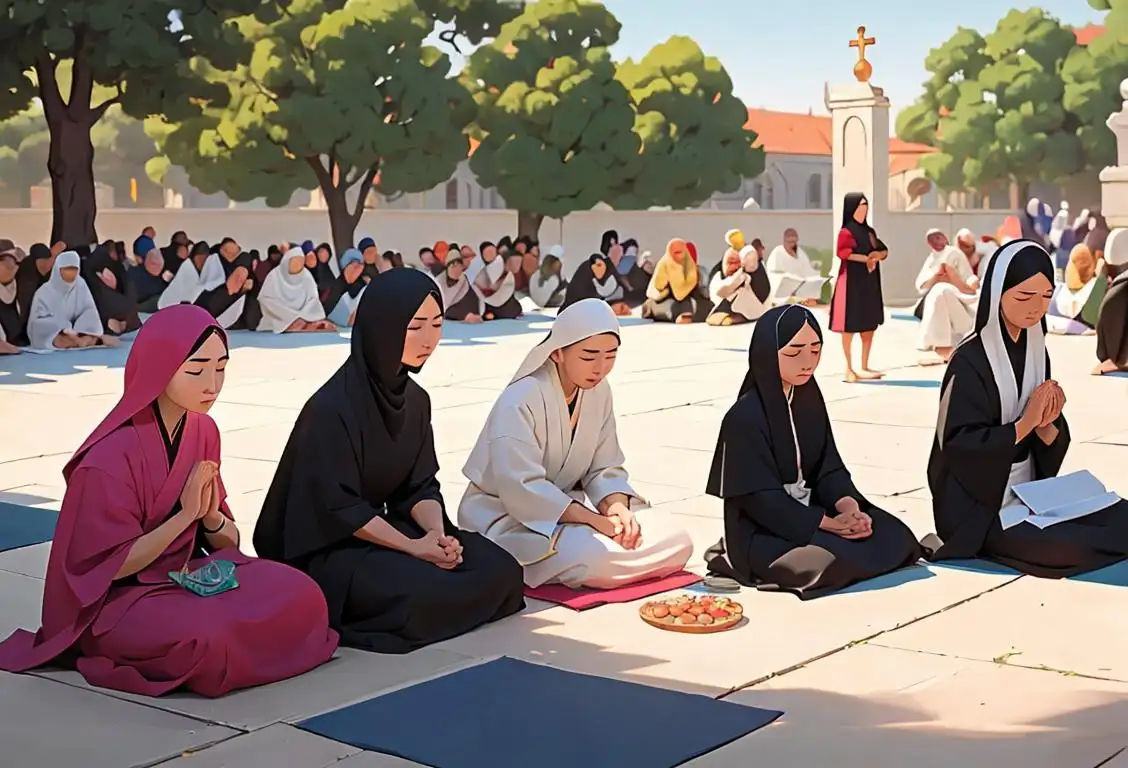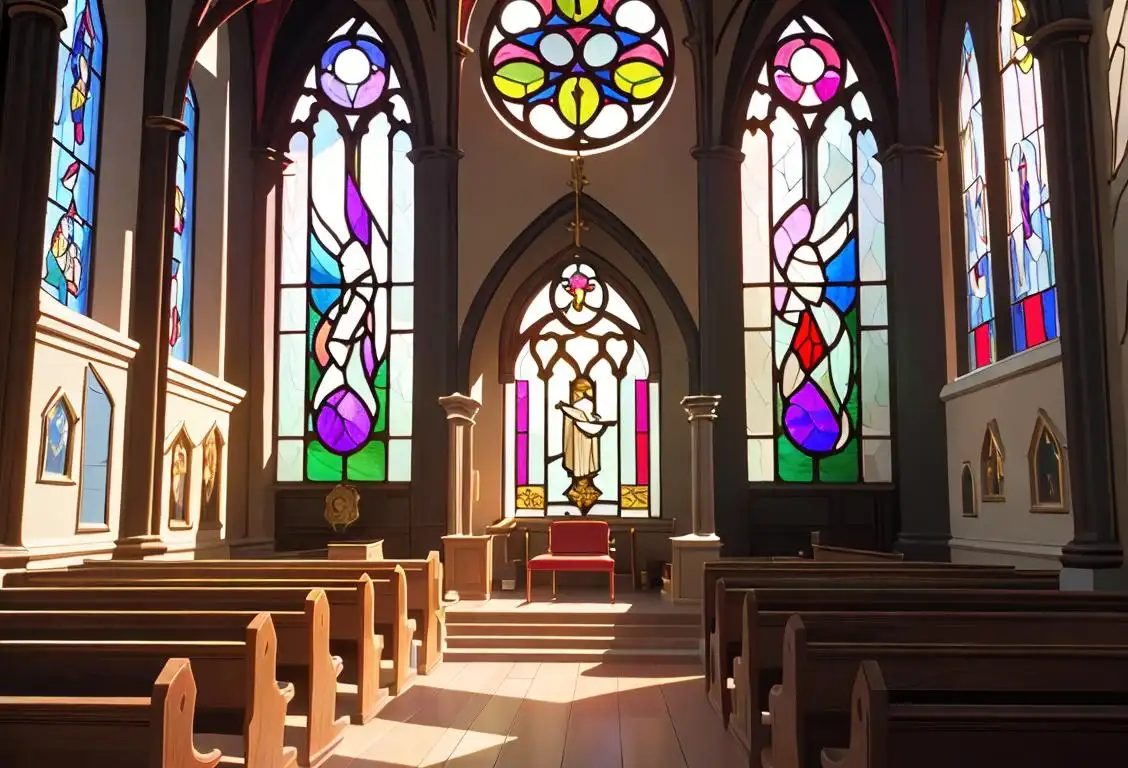National Prayer And Fasting Day

Are you ready to get down on your knees and send some prayers up to the heavens? Because today is National Prayer and Fasting Day! It's the perfect opportunity to take a spiritual breather and connect with your faith. So, grab your prayer beads and put on your fasting pants, because we're about to dive into a day of reflection, devotion, and a dash of hunger.
When is Prayer And Fasting Day?
It's national prayer and fasting day on the 25th March.
A Divine Tradition
Every year on National Prayer and Fasting Day, people from various religious backgrounds come together to partake in prayer and fasting. Whether you're a seasoned devotee or someone exploring their spirituality, this day offers a chance to reflect, seek guidance, and show gratitude.
A Time for Reflection
Prayer has been a part of human culture for centuries. It's a way for individuals to communicate with their higher power, seeking solace, peace, and guidance. National Prayer and Fasting Day encourages people to take a moment to reflect on their blessings, offer support to others, and strengthen their spiritual connection.
Embrace the Hunger
Fasting, the act of abstaining from food or certain types of food, is a common practice during National Prayer and Fasting Day. It's believed that by forgoing physical nourishment, individuals can focus more on their spiritual well-being and engage in deeper introspection. While fasting can vary in duration and intensity depending on personal beliefs, it's a way to demonstrate discipline and commit to one's faith.
A Global Day of Devotion
National Prayer and Fasting Day may have originated online, but its impact has transcended the digital realm. People from all corners of the world participate in this day of devotion, sharing their prayers and joining in collective fasting. It's a beautiful reminder of the power of faith and the unity it can bring to our global community.
History behind the term 'Prayer And Fasting'
10th century BCE
Early Origins
Prayer and fasting have deep roots in religious practices and can be traced back to ancient civilizations. In the 10th century BCE, fasting was mentioned in the Hebrew Bible as a form of repentance and seeking God's guidance. It was often accompanied by prayer, symbolizing a spiritual connection with the divine.
3500 BCE
Ancient Origins
The practice of prayer and fasting can be traced back to ancient civilizations such as the Mesopotamians and Egyptians. These cultures believed that by abstaining from food and focusing their thoughts on the divine, they could connect with the spiritual realm and achieve enlightenment or favor from the gods.
5th Century
Emerging Practice
In the 5th century, the practice of prayer and fasting began to emerge as a significant aspect of Christian spirituality. This practice involved setting aside specific times for devoted prayer and abstaining from food or certain activities as a form of spiritual discipline. It was believed to foster a closer relationship with God and promote personal reflection and repentance.
5th Century
Early Christian Practices
In the 5th century, prayer and fasting began to gain prominence in early Christian communities. Believers would dedicate specific times to pray and abstain from food, seeking spiritual purification and guidance.
3000 BCE
Early Practices
Prayer and fasting have roots in ancient civilizations such as Mesopotamia and Egypt. In these early times, people practiced various forms of prayer and fasting as a way to connect with the divine. Fasting involved abstaining from food or certain activities as a form of spiritual discipline, while prayer was a means of communicating with gods and seeking their favor.
Ancient Times
Origins of Prayer and Fasting
Prayer and fasting have been practiced in various cultures and religions since ancient times. In many ancient civilizations, fasting was seen as a way to purify the body and achieve a higher state of consciousness. Prayer, on the other hand, was a means of connecting with the divine and seeking guidance. These practices were often intertwined, with fasting being accompanied by prayer to enhance its spiritual significance.
5th century AD
Early Christian Practices
The term 'prayer and fasting' can be traced back to the early Christian practices of the 5th century AD. During this time, devout Christians would engage in periods of intensified prayer and fasting as a way to seek spiritual purification and growth. They believed that by abstaining from food and other earthly pleasures, they could focus their energies on connecting with God and seeking His guidance.
Ancient Times
Origins of Prayer and Fasting
Prayer and fasting have been practiced since ancient times as forms of spiritual discipline and devotion. In various civilizations, including ancient Egypt, Greece, and Rome, people engaged in fasting and prayer as a means of connecting with the divine. These practices were believed to have purifying and transformative effects on the body and soul.
6th Century
Monastic Influence
During the 6th century, the practice of prayer and fasting became more structured and influenced by monastic traditions. Monks would engage in rigorous fasts and prolonged prayer sessions, serving as an inspiration for the wider Christian community.
6th century BCE
Religious Significance in Judaism
The practice of prayer and fasting gained significant religious significance within Judaism. The Hebrew Bible, specifically the Book of Esther and the Book of Jonah, mentions fasting and prayer as means of repentance and seeking divine intervention. Fasting during Yom Kippur, the Day of Atonement, became an important ritual for Jews, symbolizing repentance and purification.
9th century BCE
Influence of Judaism
The concept of prayer and fasting gained significance in Judaism. The Hebrew Bible mentions numerous instances where people fasted and prayed as acts of repentance, seeking guidance, or expressing devotion to God. Fasting on the Day of Atonement (Yom Kippur) became one of the most important and widely observed fasts in the Jewish tradition.
5th century BCE
Ascetic Traditions
During the 5th century BCE, various ascetic traditions emerged in different cultures, including Greek philosophy and Jainism. These traditions emphasized self-discipline, self-control, and self-denial as means to attain spiritual enlightenment. Prayer and fasting became integral parts of these ascetic practices, aiding in the purification of the body and mind.
5th Century BCE
Biblical References
In the Bible, there are numerous mentions of prayer and fasting. In the Old Testament, fasting was frequently observed as a way to seek God's favor, repent for sins, and show devotion. The prophet Daniel, for example, fasted and prayed for three weeks, seeking understanding from God. In the New Testament, Jesus himself engaged in prayer and fasting during his 40 days in the wilderness, setting an example for his followers.
Early Christianity (1st Century AD)
Fasting and Prayer in Early Christianity
In the early years of Christianity, prayer and fasting held great importance. The New Testament accounts, particularly in the Gospels, mention Jesus fasting in the wilderness for 40 days and nights as a spiritual preparation. Inspired by Jesus' example, early Christians adopted fasting and prayer as vital components of their faith. These practices were believed to enhance spiritual growth, seek divine guidance, and seek forgiveness for sins.
6th century AD
Monastic Traditions
In the 6th century AD, prayer and fasting became a significant part of monastic traditions. Monks and nuns would dedicate themselves to a life of prayer and contemplation, often incorporating extended periods of fasting into their daily routines. These devoted individuals saw fasting as a way to discipline the body, purify the soul, and strengthen their spiritual connection with God.
6th Century
Establishment of Lent
In the 6th century, the practice of prayer and fasting became more formalized with the establishment of the season of Lent. Lent is a 40-day period leading up to Easter, in which Christians traditionally engage in prayer, fasting, and penance. This period of self-reflection and preparation emphasizes the 40 days Jesus spent fasting in the wilderness before beginning his public ministry.
1st century CE
Christianity and Fasting
With the advent of Christianity, prayer and fasting became integral to the religious practices of early Christians. Jesus himself engaged in a significant period of fasting and prayer for 40 days in the wilderness. Christians adopted fasting as a means of purifying the body and soul, seeking spiritual strength, and imitating Christ's example.
Medieval Era (5th - 15th Century)
Fasting and Prayer in the Medieval Era
During the medieval era, the Catholic Church played a significant role in promoting fasting and prayer as spiritual practices. Fasting was often associated with penance and self-discipline, while prayer was seen as a means of communication with God. Monastic orders, such as the Benedictines, practiced regular fasting and incorporated it into their daily routines. Additionally, feast days and periods like Lent became occasions for intensified prayer and fasting among the general population.
1st century CE
Influence of Christianity
With the rise of Christianity, prayer and fasting became deeply ingrained in the religious practices of early Christians. Jesus Christ himself fasted for 40 days and nights in the wilderness, setting an example for his followers. The New Testament mentions fasting and prayer as powerful spiritual disciplines for seeking guidance, strength, and spiritual growth.
Early Christianity
Development of Spiritual Discipline
As Christianity spread, prayer and fasting became established as spiritual disciplines within the faith. Fasting was not only practiced for personal piety but also for communal reasons, such as seeking protection from enemies or expressing grief. Early Christian leaders like St. Augustine and St. Anthony of Egypt emphasized the importance of prayer and fasting for spiritual growth, encouraging believers to engage in these practices.
13th century AD
Medieval Penitential Practices
During the 13th century AD, the concept of prayer and fasting became intertwined with medieval penitential practices. In an effort to seek forgiveness for their sins, individuals would undertake acts of self-denial, including fasting and intensified prayer. Prayer and fasting were believed to demonstrate remorse and a genuine desire to change, enabling individuals to reconcile with both God and the Church.
11th Century
Formalization of Prayer and Fasting
In the 11th century, the Church began to formally recognize prayer and fasting as significant practices. The institution of Lenten fasting and the inclusion of prayer in formal religious services solidified their importance in Christian worship.
1st century CE
Christianity
In the 1st century CE, with the advent of Christianity, prayer and fasting took on new significance. Jesus Christ, during his ministry, emphasized the importance of prayer and fasting as a way to draw closer to God. These practices were viewed as acts of faith and spiritual discipline, allowing believers to humble themselves before God and seek His guidance.
11th Century
Fasting Regulations
During the 11th century, fasting regulations became more detailed and specific within various branches of Christianity. Different rules were established regarding the types of food that should be abstained from, the frequency of fasting, and the exemptions for certain individuals, such as the sick or elderly. Prayer and fasting were seen as spiritual disciplines that helped believers grow in faith and discipline.
4th century CE
Formalization by the Church
During the 4th century, the early Christian Church started to formalize the practice of prayer and fasting. Based on biblical teachings and the influence of early Christian leaders, fasting became an integral component of the liturgical calendar. Periods of fasting, such as Lent, Advent, and other religious seasons, were established as times for self-reflection, penance, and preparation for important feasts and celebrations.
6th century CE
Islamic Tradition
In the 6th century CE, Islam was founded by Prophet Muhammad, who introduced prayer and fasting as essential pillars of the faith. Muslims observe fasting during the holy month of Ramadan, abstaining from food, drink, and other physical needs from sunrise to sunset. This practice serves as a manifestation of self-control, devotion, and empathy towards those who are less fortunate.
5th century CE
Lenten Fasting
The tradition of Lenten fasting emerged during the 5th century as a focused period of prayer and fasting leading up to Easter. This 40-day period, symbolic of Jesus' time in the wilderness, became a time for Christians to reflect, repent, and prepare for the celebration of Jesus' resurrection.
16th Century
Protestant Reformation
The Protestant Reformation, which took place in the 16th century, brought about changes in the understanding and practice of prayer and fasting. Martin Luther, one of the key figures in the Reformation, criticized the excessive regulations and emphasized the importance of genuine faith and spiritual sincerity. This led to a reconsideration of the traditional practices associated with prayer and fasting.
14th Century
Expansion of Spiritual Disciplines
By the 14th century, prayer and fasting had become established disciplines within various Christian denominations. Additional spiritual practices, such as the Stations of the Cross, further highlighted the connection between prayer, fasting, and spiritual growth.
Reformation and Counter-Reformation (16th Century)
Emphasis on Personal Piety and Devotion
The 16th-century Reformation brought about significant changes in religious practices. Martin Luther and other reformers emphasized personal piety and direct communication with God through prayer. The emphasis shifted from mandatory fasting to voluntary acts of devotion. Prayer and personal reflection became central to individual spiritual growth and understanding. However, some Catholic leaders responded to the Reformation with the Counter-Reformation, reinforcing the importance of fasting and prayer in the Catholic tradition.
16th century AD
Reformation and Spiritual Discipline
The 16th century AD saw the rise of the Protestant Reformation, which brought about significant changes in Christian practices. During this time, prayer and fasting continued to be upheld as important spiritual disciplines. Leaders such as Martin Luther and John Calvin emphasized the necessity of prayer and fasting for personal spiritual growth and as a means to draw closer to God.
Middle Ages
Liturgical Observances
During the Middle Ages, the Catholic Church formalized the practice of prayer and fasting through liturgical observances. Lent, the period of 40 days leading up to Easter, became a significant time of fasting and prayer for Catholics. The faithful were expected to abstain from certain foods, intensify their prayers, and engage in acts of penance. The concept of prayer and fasting as a means of spiritual preparation and self-discipline continued to resonate throughout this period.
Modern Era (20th Century)
Interfaith Dialogue and Global Practices
In the modern era, prayer and fasting have taken on new dimensions. With the rise of interfaith dialogue, people from various religious backgrounds have come to recognize the shared value of prayer and fasting as spiritual practices. These practices serve as unifying rituals, fostering understanding and respect among different faiths. Additionally, beyond religious contexts, practices like intermittent fasting have gained popularity for health benefits. Prayer and fasting continue to evolve, adapting to the changing cultural and religious landscape of the world.
20th Century
Renewed Interest
In the 20th century, there was a renewed interest in prayer and fasting as part of spiritual revival movements. Many individuals and communities recognized the significance of these practices in deepening their relationship with God and seeking spiritual renewal. Prayer and fasting were seen as means to seek guidance, break free from harmful habits, and draw closer to God in times of personal or communal struggles.
7th century CE
Islamic Practices
In Islamic tradition, prayer and fasting are central pillars of faith. Muslims observe the holy month of Ramadan, during which they abstain from food and drink from dawn to dusk and engage in increased prayer and worship. Ramadan is seen as a time of heightened spirituality, self-discipline, and seeking closeness to Allah.
16th Century
Reformation Impact
During the 16th century Protestant Reformation, the significance of prayer and fasting was redefined within different theological perspectives. Reformers emphasized personal piety and the individual's direct relationship with God, leading to diverse interpretations and approaches to these practices.
21st century
Modern Spiritual Practices
In the 21st century, the term 'prayer and fasting' is still used to describe periods of time when individuals, communities, or religious groups come together to engage in intentional prayer and voluntary fasting. While the specific practices and beliefs around prayer and fasting may vary across different religions and denominations, the fundamental purpose remains centered on seeking spiritual growth, guidance, and connection with the divine.
Modern Times
Interfaith and Secular Adoption
In modern times, prayer and fasting have expanded beyond specific religious contexts. Many different faith traditions incorporate prayer and fasting as part of their spiritual practices and observances. Additionally, individuals who do not adhere to any particular religion may also engage in prayer and fasting for personal reasons, such as mindfulness, self-reflection, or health benefits. These practices continue to evolve and take on new meanings in our diverse and multicultural world.
16th century CE
Reformation and Diverse Practices
The Protestant Reformation in the 16th century brought changes to the practice of prayer and fasting. Different Protestant denominations developed diverse interpretations and practices of fasting, influenced by their theological beliefs. Some emphasized the importance of spiritual introspection and self-discipline, while others downplayed the significance of fasting as external observance and focused more on the sincerity of one's heart.
13th century CE
Mendicant Orders
During the 13th century CE, mendicant orders, such as the Franciscans and Dominicans, emerged within the Catholic Church. These religious orders embraced a life of poverty, promoting prayer and fasting as means to detach from worldly possessions and focus on spiritual pursuits. Their devotion to prayer and fasting became central to their religious vocation.
20th century CE
Renewed Interest
In the 20th century CE, there was a renewed interest in prayer and fasting as spiritual disciplines beyond religious institutions. Various spiritual movements and individuals explored the transformative power of prayer and fasting for personal growth, introspection, and connection with a higher power. These practices continue to be observed by people from different religious backgrounds seeking spiritual fulfillment.
20th century CE
Interfaith and Secular Adoption
In the 20th century, prayer and fasting gained broader acceptance beyond religious contexts. Interfaith movements and global events such as World Day of Prayer promoted unity through prayer across different faith traditions. Additionally, fasting for non-religious reasons, such as protest or political activism, gained popularity, with individuals and groups using fasting as a means to raise awareness and advocate for social justice.
20th Century
Interfaith Dialogues
In the 20th century, interfaith dialogues between Christians and practitioners of other religions highlighted the commonality of prayer and fasting across different faith traditions. These dialogues fostered mutual understanding and appreciation for the spiritual significance of these practices.
Modern Era
Interfaith Observance
In recent times, prayer and fasting have gained recognition and participation across various religious and spiritual traditions. Many individuals and communities observe periods of fasting and prayer as acts of devotion, spiritual cleansing, self-discipline, or as a means of seeking guidance and connection with the divine.
Present
Continued Relevance
Today, prayer and fasting continue to hold importance within various religious communities worldwide. The practices are seen as ways to deepen one's spirituality, seek divine guidance, and reflect on personal values and intentions.
Did you know?
Did you know that the concept of fasting for spiritual purposes has been practiced by various cultures and religions throughout history? From ancient Egyptians to Buddhists, fasting has been a common practice to achieve spiritual enlightenment and cultivate a deeper connection with the divine.Tagged
awareness spirituality faithFirst identified
18th October 2015Most mentioned on
25th March 2020Total mentions
312Other days
Prayer And Fasting Day
Prayer Prayer Day
Fasting And Prayer Day
Call To Prayer Day
Faith Hiv And Aids Awareness Day
Back To Church Day
Buddhist Day
Rosary Rally In Washington Dc In Day
Prayer Breakfast And Does Not Go To The Other End Of The Day
See You At The Pole Day








